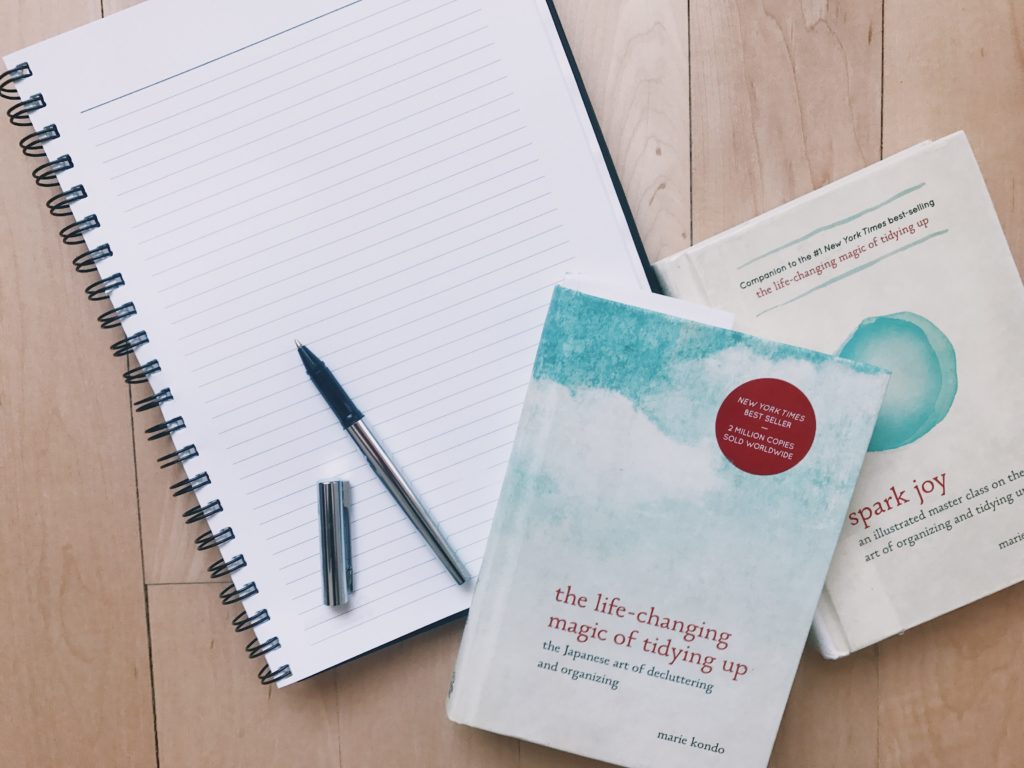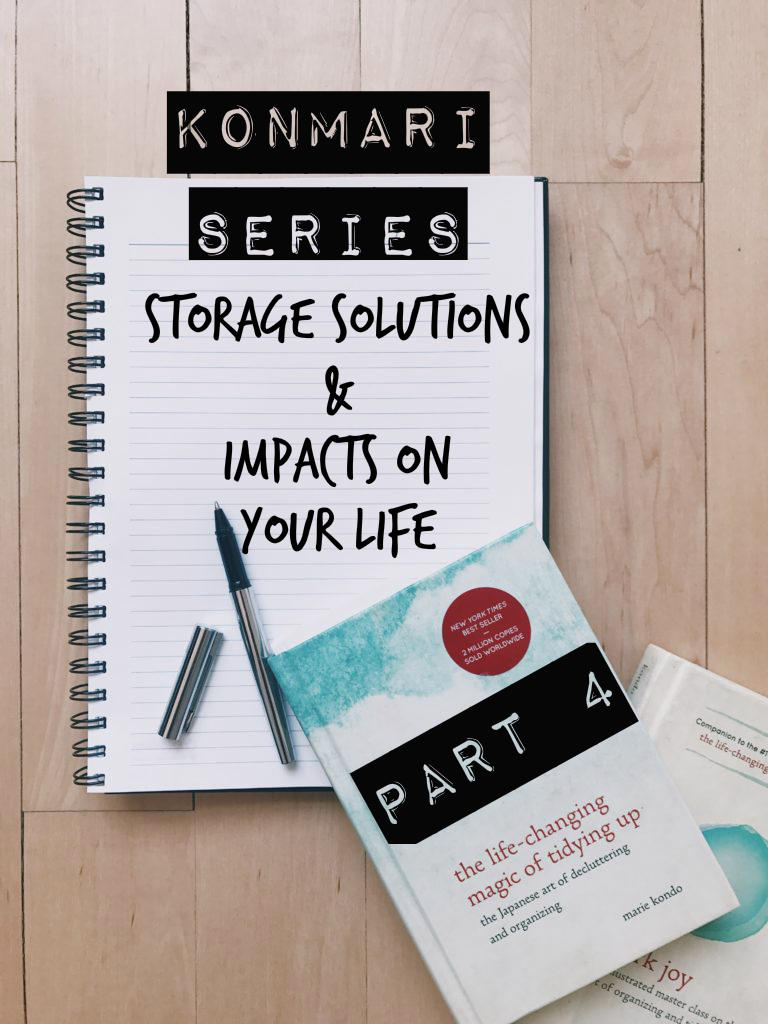This post is part of the KonMari Series in which I document my journey to becoming a certified KonMari organizing consultant. Start from the beginning here and/or see all posts of the series here.
I’m summarizing my notes of part of Marie Kondo’s first book “The Life-Changing Magic Of Tidying Up.” Since I took a looot of notes, I’m dividing my writing about this book into three posts (find the first post here). In today’s (third) post, I am writing about storage solutions for the items one decides to keep. I will also go over how the process of tidying your belongings can transform your whole life.
Please note that this should not serve as a complete summary of the book. However, it is merely a roundup of points that stood out to me and that I found important. I also add my personal reflections to some aspects.
Every Item Needs A Home
The most important thing to keep in mind is that you need to designate a specific place for each item. Every thing needs to have a home. Only then you can keep your space from getting cluttered anew.
Marie Kondo claims that there is no such thing as not enough storage space. In her opinion, every house/room/apartment has just the perfect amount of space to store all the things. She also wants you to keep storage as simple as possible and states that complicated storage only keeps you from seeing your belongings.
Kondo lays down merely two rules regarding storage:
- Store items of the same type in the same place
- Don’t scatter storage space
Also, there are two ways of categorizing belongings: by item type and/or by person. Every person in a home should have a room where he or she can store her/his items. It’s not always possible for each person to have her/his own room. Thus, if that’s not possible, every person should at least have a designated space where she/he can store her/his personal items.
No Storing As Per Flow Or Frequency Of Use?
Kondo is not an advocate of storing things according to “flow” or “frequency of use.”
Clutter is caused by a failure to return things to where they belong. Therefore, storage should reduce the effort needed to put things away, not the effort needed to get them out.
I don’t agree with her here 100%. I think that you can store items according to how things flow in a household (e.g., put your keys somewhere near the door) or keep things handy if you’re using them often (e.g., if you cook often and frequently use spices, you might keep them near the stove) without breaking Kondo’s two primary storage rules. In my mind, you should strive to store items that you use very frequently in a way that makes sense and that doesn’t require unnecessary effort to reach them.
Vertical Storage
Kondo notes that objects are typically not returned back to their designated place if they don’t actually have one (obviously) or if it’s complicated to put them back. You can make things easy to put back by storing everything (as much as possible) so that you can see it. Kondo’s default method of storage also helps in returning items back to their home with ease. She recommends vertical storage for basically everything from clothes to papers. (I will write in more detail about how to store things when I summarize my notes about Kondo’s second book in upcoming posts.)
You should avoid piling things up for several reasons:
- It takes up too much space
- It is “hard on things at the bottom” of the pile
- You likely forget about bottom items (and thus tend to accumulate more stuff)
No Fancy Storage Items
Marie Kondo’s criteria for items that help you store your belongings are simple. She looks at size, material, durability, ease of use and attractiveness. You should not waste your time and money to look for and buy complicated storage solutions. Instead, you should look at what you already have in your home such as boxes or bins. Kondo’s favorite storage items are actually shoe boxes which you can use for clothing and put in drawers.
More Storage Wisdom
Kondo recommends to empty your bag every single day. This couldn’t resonate with me more because it makes life just easier. First of all, you might want to use a different bag the next day. If all the things are in their designated place, you can easily fill your bag with the things you want to bring with you. Second, if you empty your bag every day you’re less likely to lug around a heavy bag with things you don’t need on a daily basis (I’m looking at you, hubby, who never ever empties his backpacks and suitcases).
If possible, you should move all storage units in a built-in closet. I guess it makes sense if you have a big enough closet. But it might get a bit messy in my opinion if your closet is small. It really depends on your living situation and the layout of your home if this is an option for you.
As a general principle you want to keep things off the floor. This is something I’ve been finding very helpful and are doing it more and more. It just makes cleaning easier and also helps tremendously with an uncluttered appearance. I’ve been loving pegboards and grid walls lately for that reason and have slowly been making changes in our apartment.
Unpacking and de-tagging new clothing items immediately might seem obvious to many of you. To me it does at least. But apparently it seems to be a thing to not do this right when you bring your new things home as experienced by Kondo as well as by myself (again, referring to my husband). Unpacking and de-tagging only benefits you (more likely to start using it), your clothes (does less harm to them) and your space (takes up less space). So do it.
Another thing that Kondo mentions is that you might want to remove the labels from bottles, containers, etc. By doing that you can remove the “noise” these labels can create in your home. Your home might be tidy but it might still feel cluttered if you have a lot of items with written information on them.
A central concept Kondo mentions throughout the book is that you should show appreciation for your belongings. Your things serve and “work hard” for you. Thus, you should treat them accordingly. Thank them and treat them in a way that shows your respect for them and gives them the rest needed when storing them away.
The Magic Of Tidying Transforms Your Life
For Kondo, tidying your home is only a means to improve your life. Your end goal is not to have an organized living space but to have a happy and fulfilled life. According to Kondo’s experience, many people discover what they really want to do with their life after decluttering and organizing their home.
By tidying your home you become better at making decisions. Not only in making decisions regarding your belongings but in making decisions in other areas of your life.
Letting go of things is more important than adding stuff. Because letting go is the part most people struggle with tremendously. The reasons you have trouble letting go of things are the following:
- Attachment to the past and/or
- Fear of the future
Many people are surprised that getting rid of things doesn’t hurt them later on. In fact, it makes them lighter and overall happier (even if you sometimes regret having to let go of one thing or another). And it can have positive effects on different areas in your life such as your physical appearance, your hobbies, mood and career.
——————–
In the next part of the KonMari series I will start sharing my notes on Marie Kondo’s second book “Spark Joy.”


